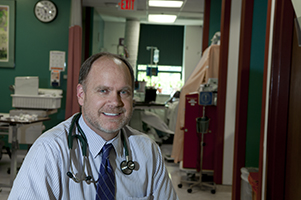Jeff Lennox, MD, is an Emory professor of medicine, Emory chief of internal medicine at Grady Memorial Hospital and the former medical director of the infectious disease program at the Ponce de Leon Center. “At Grady, we see patients from every continent except Antarctica, so we take care of patients with a wide variety of infectious diseases,” he says.” In addition, Grady has one of the largest populations of HIV-infected patients in the United States.” Here, Lennox tells how he came to specialize in infectious disease and HIV.
A new disease: As a medical student, I was fascinated with bacteria and how infections circumvent our immune system. In my second year of medical school, there were reports from San Francisco and New York of a group of patients who had a new syndrome of acquired immunodeficiency. At first, the thought was that it might be due to a known pathogen, a toxin exposure, or possibly to an unknown infection. There was a nervousness among healthcare personnel about such a mysterious ailment.

Pessimism prevailed: Once the viral cause was discovered, people could better understand it, but there was a lot of pessimism around viral infections. They were difficult to treat effectively. The pessimists, luckily, were ultimately proven wrong. The success of HIV treatments shows you the amazing things that medical technology can do in this modern era.
First treatment for HIV: There was essentially no treatment for AIDS until 1987 following the approval of Zidovudine (also known as azidothymidine, or AZT). When it was approved, it brought a lot of hope to people, but it was a very difficult medicine to take. Side effects included nausea, headache, anemia, and it had to be taken every four hours. Initially it only added four months of life for the average patient.
More breakthroughs: Doctors began checking for the amount of virus in the blood, so they were able to tell more accurately if a medicine was working, as opposed to waiting for results of one- to two-year-long clinical trials. One of the reasons I came to Emory is because Emory investigators contributed to the development of 3TC. In 1995, lamivudine (also known as 3TC) was introduced. It showed strong promise when combined with other drugs. In 1995-96, a combination of Zidovudine, 3TC, and a protease inhibitor was a huge step. It reduced viral load to undetectable levels, patients’ T-cell levels actually went up, and death rates fell.
Eureka! When we first saw this data, short of my wedding day and the birth of my children, this was the most euphoric moment in my entire life. All at once it was clear that we could offer patients real, long-lasting benefits.
 Down to one pill: The next major breakthrough was the introduction of integrase inhibitors. They are nontoxic, very potent, and rapidly reduce the viral load—in two to six weeks it becomes undetectable. Now, more than 90 percent of people with HIV start treatment with just one pill once a day that includes an integrase inhibiter, and obtain an undetectable viral load.
Down to one pill: The next major breakthrough was the introduction of integrase inhibitors. They are nontoxic, very potent, and rapidly reduce the viral load—in two to six weeks it becomes undetectable. Now, more than 90 percent of people with HIV start treatment with just one pill once a day that includes an integrase inhibiter, and obtain an undetectable viral load.
A cure? Not yet. But let’s just say that 10 years from now in 2028, I can’t even imagine the technology were going to have. If you had told me in 1998 what we’d be doing now, twenty years later, it would’ve just amazed me. I mean, I couldn’t even have comprehend some of the things were now doing, so I’m very hopeful for the future.
Crossover impact: With virus treatments, many times there are benefits that help other diseases. For example, 3TC and FTC help against hepatitis B—the World Health Organization has 3TC on their list of essential medicines because of activity against both HIV and Hep B. Medications are being repurposed to see if they will help patients with HIV, not by attacking the virus itself, but some of its symptoms. Researchers are also testing treatments to prevent HIV associated bone fractures, and statins used to prevent heart attacks are being tested in HIV infected patients.
Innovative care: The Ponce center was purchased for a dollar. There was some resistance to having an HIV treatment center in Midtown Atlanta, but people rallied, put up signs. Once opened, it was one of the most innovative HIV care centers in the U.S. It offered treatments for cancers associated with HIV, dental care, psychiatry, a pediatric unit, even a food pantry and assistance with transportation and housing. The Ponce Center itself is a bright, colorful, cheerful building, with donated artwork. There was a coming together of the community to really try and provide an environment where patients felt like people were caring about them and caring about the fact that they were suffering from AIDS. Only the sickest of the sick were funneled into the Ponce clinic, making it unique. The center partnered with the AIDS Clinical Trials Group, which was an NIH-funded research group testing breakthrough therapies.
Current research: I am researching acute HIV—when you first get the virus. There is evidence to show that treating people very early on might lower the number of latently infected cells, which could help with cures in the future. I am also testing medications for cure strategies, and medications for preventatives. Currently a combination of FTC and Tenofovir, taken together, prevent someone from getting HIV. We are also testing injectable antivirals, so no pill has to be taken every day, and injectable antibodies that might be able to prevent HIV.
Why are there still AIDS cases? Some patients are not completely adherent to treatment, some have no insurance and no access to treatment. People who are not on treatment can pass the infection on to others.
Advice to younger self: Find something you’re passionate about and pursue it. Also, throughout life, keep an open eye for unexpected paths that lead you to your goals.
Go here to watch the stories of those involved and those who benefited from the discovery of 3TC & FTC. Go here to read the full series of blog interviews with inventors, patients, and others.